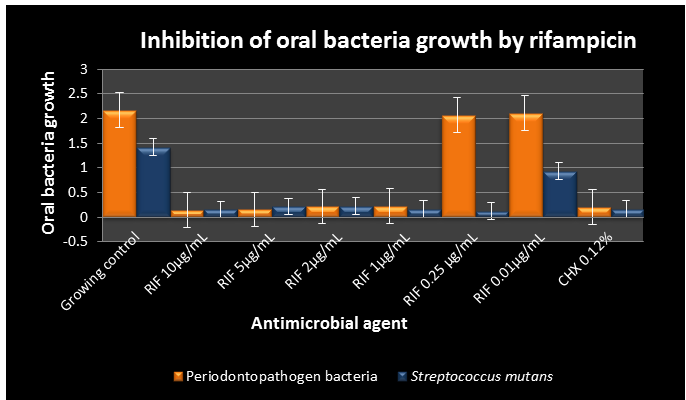Toll Free Helpline (India): 1800 1234 070
Rest of World: +91-9810852116
Free Publication Certificate
Vol. 2, Issue 3 (2013)
Rifampicin and N-acteylcisteyne Inhibit Oral Bacterial Growth and Biofilm Formation
Author(s):
Hernandez-Romero Cindy, Hernandez-Delgadillo Rene, Galindo-RodrÃguez Sergio, Reséndez-Pérez Diana, Flores-González MarÃa del Socorro, Cabral-Romero Claudio
Hernandez-Romero Cindy, Hernandez-Delgadillo Rene, Galindo-RodrÃguez Sergio, Reséndez-Pérez Diana, Flores-González MarÃa del Socorro, Cabral-Romero Claudio
Abstract:
Dental plaque consists in a biofilm of pathogen microbes. Some oral bacteria have high homology with M. tuberculosis regarding growth, slow metabolism and cell division. Rifampicin is the first election to treat active tuberculosis; however there are no reports about the capability of rifampicin against oral bacteria. N-acetylcysteine (NAC) is a mucolytic agent with antibiofilm properties, but it is unknown their ability to disrupt oral bacteria biofilm. The aim of this study was determine the bactericidal and antibiofilm effectiveness of rifampicin/N-acetylcysteine against oral microbes. The bactericidal activity to interfere with oral bacteria growth was analyzed by cell viability MTT assay. Anti-biofilm activity explored by fluorescence microscopy. The result of MIC was 1 μg/ml against periodontopathogen bacteria and 0.25 μg/ml for S. mutans. Rifampicin was capable to inhibit the oral biofilm formation in inoculation time. NAC had antibiofilm activities at 200 mg/ml and the mix rifampicin/NAC was capable to eradicate a 4-8 hrs biofilm.
Dental plaque consists in a biofilm of pathogen microbes. Some oral bacteria have high homology with M. tuberculosis regarding growth, slow metabolism and cell division. Rifampicin is the first election to treat active tuberculosis; however there are no reports about the capability of rifampicin against oral bacteria. N-acetylcysteine (NAC) is a mucolytic agent with antibiofilm properties, but it is unknown their ability to disrupt oral bacteria biofilm. The aim of this study was determine the bactericidal and antibiofilm effectiveness of rifampicin/N-acetylcysteine against oral microbes. The bactericidal activity to interfere with oral bacteria growth was analyzed by cell viability MTT assay. Anti-biofilm activity explored by fluorescence microscopy. The result of MIC was 1 μg/ml against periodontopathogen bacteria and 0.25 μg/ml for S. mutans. Rifampicin was capable to inhibit the oral biofilm formation in inoculation time. NAC had antibiofilm activities at 200 mg/ml and the mix rifampicin/NAC was capable to eradicate a 4-8 hrs biofilm.

Fig.: fig 1
Pages: 16-23 | 1681 Views 154 Downloads

How to cite this article:
Hernandez-Romero Cindy, Hernandez-Delgadillo Rene, Galindo-RodrÃguez Sergio, Reséndez-Pérez Diana, Flores-González MarÃa del Socorro, Cabral-Romero Claudio. Rifampicin and N-acteylcisteyne Inhibit Oral Bacterial Growth and Biofilm Formation. Pharma Innovation 2013;2(3):16-23.






